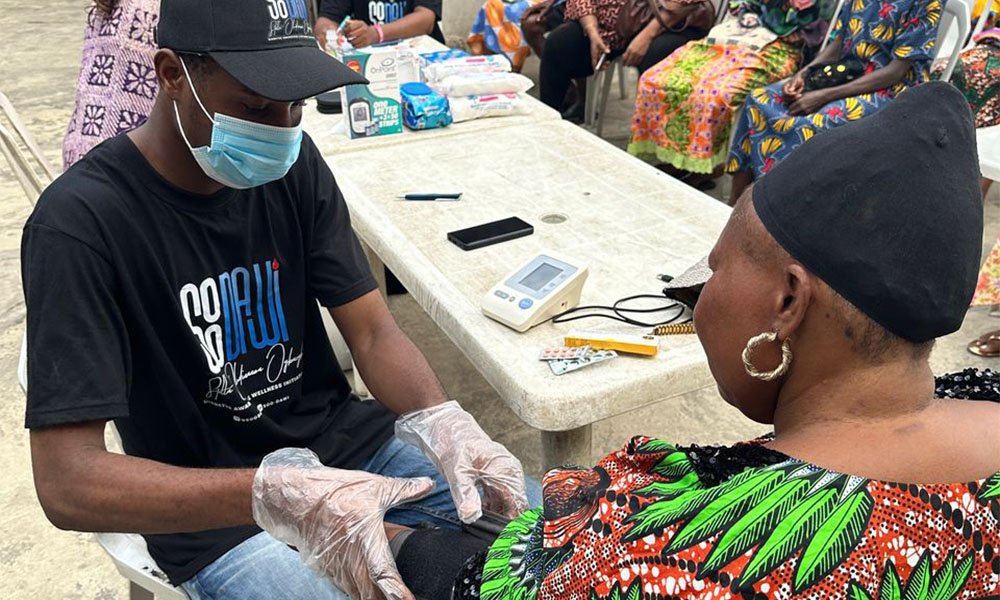Why We Do What We Do
The Urgency
THE DISEASE
Diabetes
The burden of diabetes is most significant among adults aged 20–79, with prevalence increasing as people get older.
Diabetes, a chronic disease characterised by raised blood glucose level, known as hyperglycaemia, is a silent but deadly health crisis in Africa, affecting millions and often going undiagnosed until severe complications arise. According to the International Diabetes Federation (IDF), an estimated 24 million people in Africa were living with diabetes in 2021, a number projected to increase by 129% to 55 million by 2045. Shockingly, more than 54% of these individuals remain undiagnosed, putting them at risk for life-threatening complications such as heart disease, kidney failure, amputations, and many more.
The Why

The African region faces significant barriers to diabetes care, including limited access to essential medicines, expensive treatment costs, and a lack of awareness. With only 36% of public hospitals providing essential medicines for chronic diseases, many people, especially in low-income and rural communities, struggle to get proper care.
SOO-DAWI was founded to bridge this gap by providing accessible diabetes education, screenings, and support systems focusing on under-resourced communities in Africa.
The Challenge
The Silent Epidemic: Prediabetes & Diabetes in Africa
Diabetes is a growing public health crisis in Africa, yet millions remain unaware of their condition. Prediabetes, where blood sugar levels are elevated but not high enough for a diabetes diagnosis, serves as a silent warning sign. Without intervention, up to 70% of individuals with prediabetes will develop type 2 diabetes, increasing the risks of heart disease, kidney failure, and nerve damage.
- Alarming Growth – As of 2021, 40.9 million adults in Africa had prediabetes, a number projected to double to 84.7 million by 2045. (Heliyon, 2023)
- Undiagnosed Cases – Sub-Saharan Africa has the highest rate of undiagnosed diabetes globally, with 70% of people unaware of their condition (WHO Africa, 2021).
- Atypical Symptoms – Unlike in Western countries, type 2 diabetes in Africa often affects individuals who are not obese, making detection more difficult. (NIH, 2023)
High Prevalence of Diabetes Complications In Africa
In Africa, diabetes complications are widespread and significantly contribute to the region's health burden. Studies indicate that conditions like retinopathy, nephropathy, neuropathy, and cardiovascular diseases affect a large portion of individuals with diabetes. The prevalence of these complications varies across the continent, with retinopathy affecting 8.1% to 41.5%, nephropathy 6.7% to 46.3%, neuropathy 21.9% to 60%, and albuminuria 21% to 22% of diabetic patients in Northern Africa (BMC Public Health, 2013).
- Higher Mortality Rate – These complications lead to higher mortality rates, with over 321,000 deaths attributed to diabetes in Africa in 2015.
- Increase in Premature Deaths – Additionally, the continent has a higher rate of premature diabetes-related deaths, with 58% occurring before the age of 70, surpassing the global average of 48% (WHO Regional Office for Africa, 2022).
Lack of Early Diagnosis & Awareness
A significant portion of Africa’s population is unaware of their diabetes status, resulting in delayed diagnoses and increased health risks. An estimated 54% of people living with diabetes in Africa remain undiagnosed, contributing to higher mortality rates compared to global averages (WHO Africa, 2022).
- Large Undiagnosed Population – More than half of people with diabetes in Africa remain undiagnosed, leading to severe complications before they receive treatment.
- Delayed Symptoms – Often called a "silent killer," diabetes can take years to present noticeable symptoms, increasing the risk of life-threatening conditions.
Economic & Healthcare Barriers
Access to affordable diabetes medications remains a critical challenge across Africa. Studies show that only 33.5% of healthcare facilities in the region have short-acting insulin available, while 54.9% stock metformin, a standard oral medication for Type 2 diabetes. Even when accessible, the high cost of insulin presents a major obstacle often amounting to a full week's wages for low-income individuals in many African countries (Tropical Medicine & International Health, 2022).
- Expensive Treatment – The cost of diabetes management remains unaffordable for many, compounded by limited healthcare infrastructure and restricted access to essential medicines.
- Healthcare Burden – Africa's healthcare systems are primarily focused on infectious diseases, creating a dual burden of managing both communicable and non-communicable diseases.
